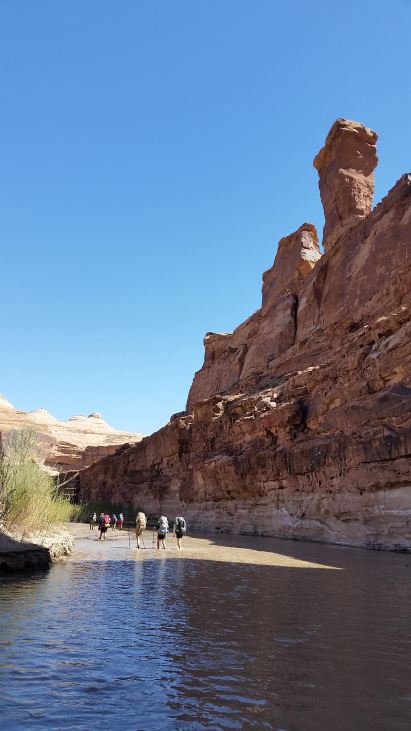Peering over the rim of Horseshoe Canyon, I sifted through shadows of boulders, junipers, and pinyon pines for evidence of water. I knew there must be some, as it would be our  drinking water for the next week and a half, but no water was in sight. As we descended the steep sheep herding trail, and I could clearly see the bottom of the wash, I began to question whether we would find water at all. But our instructors were not surprised at the lack of water. They simply headed up the canyon, following some sign I did not yet know how to read.
drinking water for the next week and a half, but no water was in sight. As we descended the steep sheep herding trail, and I could clearly see the bottom of the wash, I began to question whether we would find water at all. But our instructors were not surprised at the lack of water. They simply headed up the canyon, following some sign I did not yet know how to read.
That sign was a deep alcove about a quarter mile up the canyon. As we approached and turned toward the rock face, I noticed a different collection of plants flourishing: cottonwoods, wild rose, and willow. I eventually spotted the water, trickling over a rock before disappearing into the sand.
In this land of little water, places with moisture have been foci for humans for centuries. Native Americans left their rock art on the cliffs, ranchers brought their cattle, hikers explore the landscape, and politicians vie for rights to the water for the cities and industries they represent. One of the most visible impacts of humans in Horseshoe Canyon is the presence of cattle grazing. Approaching nearly every water source, there is a cattle trail. Some of the trails are evidence of feral cows, uncatchable and still residing in the canyon, but other trails are leftovers from permitted ranching decades ago. Once a trail is made it remains for hundreds of years, until the biological soil crusts are able to recover. The soil crusts are like two-inch tall villages, made of mosses, lichens, fungi, and algae; all of which help fix nitrogen, retain soil moisture, and provide habitat for seed germination. When trampled by humans or cows, the soil crusts die, thereby affecting nutrient cycling and plant regeneration.
Luckily for the soil crusts, cattle grazing in the region is on a downhill trend. During our resupply in Hanksville, we met with Mrs. Ekker, a local rancher, whose family began their ranch in 1909, amidst the maze of canyons known as Robber’s Roost. The canyons had sufficient water to sustain the family’s herd of over 10,000 cows, but as the biological soil crusts died and perennial grasses gave way to grazing-resistant, but drought intolerant, annual grasses, livestock productivity diminished. The federal government stepped in, a move counter to the individualist spirit of the West, and established a permit system that restricted grazing areas and the number of cattle a rancher could graze. The Ekker family was given a permit to continue grazing in Robber’s Roost, but many other ranchers were not able to obtain permits because they did not own land nor have access to water. Nonetheless, the Ekker family’s permit limited the number of cattle they could graze on the land, and the land was able to support fewer and fewer cattle, despite grassland restoration led by the Bureau of Land Management. By the 1970s, the Robber’s Roost herd was down to 440, hardly enough to make a living. Today, much of the water that sustained the herds is being protected for native species and for human recreation, and water is trucked in for cattle in the area, adding to ranching’s downward trend in the West.
Another major consumer of water in the West is the growing human population. Water from the Colorado Plateau joins the Colorado River and travels from Utah to California, supplying water for drinking, irrigation, recreation, and industry along the way. Water is piped from the river to distant cities such as Las Vegas and San Diego, and some of the nation’s driest landscapes are used to grow food.
Already, water from the Colorado is over allocated, and the area is in an extended drought. Snowpack is minimal, and aquifers are not able to fully recharge. The Dirty Devil River, through which we are now hiking, is lower this year than it has been in the past, and potential tar sands mining operations threaten to claim more water from the river. How long will it be before the Dirty Devil runs dry and the human populations relying on it can no longer sustain themselves? Perhaps Mrs. Ekker will be right that, “When we build a pipeline from Alaska, it won’t be for oil, but for water.”